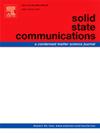Determination of silicon's melting temperature by employing Fan's formula and 37 % rule
IF 2.1
4区 物理与天体物理
Q3 PHYSICS, CONDENSED MATTER
引用次数: 0
Abstract
By employing the Fan equation in conjunction with the 37 % rule, we introduce a mathematical method to predict the melting temperature of semiconductors. The calculation does not require detailed knowledge about the material, whilst the required parameters are rather determined by the fit of the measured band gap energy variations vs. temperature. Using Si as test material, we established a melting temperature of 1665 K with an uncertainty of 121 K.
用范氏公式和37%法则测定硅的熔化温度
利用范方程和37%法则,提出了一种预测半导体熔化温度的数学方法。计算不需要对材料有详细的了解,而所需的参数是由测量的带隙能量变化与温度的拟合决定的。以Si为测试材料,确定了熔点为1665 K,不确定度为121 K。
本文章由计算机程序翻译,如有差异,请以英文原文为准。
求助全文
约1分钟内获得全文
求助全文
来源期刊

Solid State Communications
物理-物理:凝聚态物理
CiteScore
3.40
自引率
4.80%
发文量
287
审稿时长
51 days
期刊介绍:
Solid State Communications is an international medium for the publication of short communications and original research articles on significant developments in condensed matter science, giving scientists immediate access to important, recently completed work. The journal publishes original experimental and theoretical research on the physical and chemical properties of solids and other condensed systems and also on their preparation. The submission of manuscripts reporting research on the basic physics of materials science and devices, as well as of state-of-the-art microstructures and nanostructures, is encouraged.
A coherent quantitative treatment emphasizing new physics is expected rather than a simple accumulation of experimental data. Consistent with these aims, the short communications should be kept concise and short, usually not longer than six printed pages. The number of figures and tables should also be kept to a minimum. Solid State Communications now also welcomes original research articles without length restrictions.
The Fast-Track section of Solid State Communications is the venue for very rapid publication of short communications on significant developments in condensed matter science. The goal is to offer the broad condensed matter community quick and immediate access to publish recently completed papers in research areas that are rapidly evolving and in which there are developments with great potential impact.
 求助内容:
求助内容: 应助结果提醒方式:
应助结果提醒方式:


